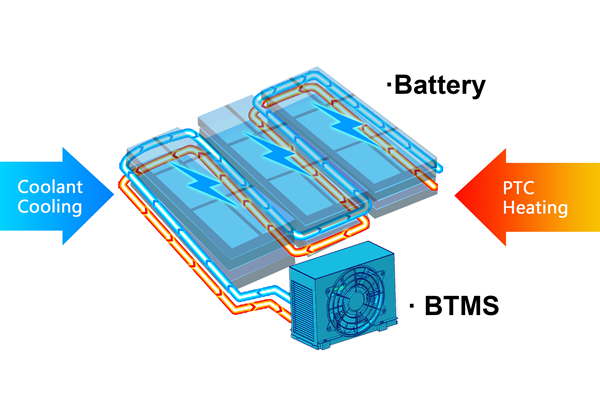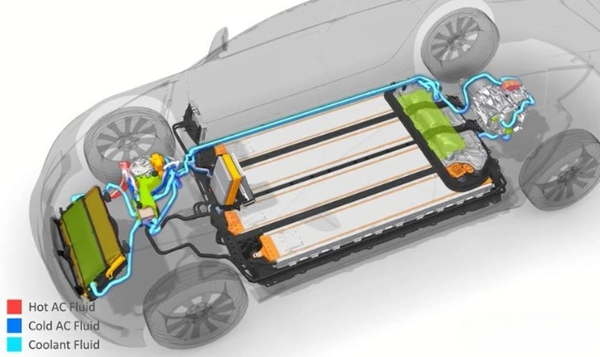Significance of Battery Thermal Management System
A battery thermal management system is a system designed to control the temperature of the battery. With the rapid development of electric vehicles and new energy vehicles, batteries have become an indispensable part of vehicles. Namun begitu, batteries are prone to overheating and overcooling during use, which in turn affects battery performance, life, and even safety. Therefore, the role of the battery thermal management system is to regulate the battery temperature promptly and maintain the battery in a good working temperature range. People’s requirements for electric vehicle range, and charging time are getting higher and higher, effective battery thermal management system is important for improving the overall performance of the battery pack. 
Characteristics Of Battery Thermal Management System
Battery thermal management system is mainly divided into active and passive two kinds. Active thermal management system is through the control of the cooling/heating system to adjust the battery temperature in time, a commonly used control system for PWM (pulse width modulation) sistem. A passive thermal management system is through the design of a reasonable structure, such as improving the heat sink wiring, increasing the heat sink, dan lain-lain. to improve the battery heat dissipation capacity, to achieve the purpose of thermal management. Sebagai tambahan, the EV battery thermal management system can also be divided into adjustable and non-adjustable. Adjustable vehicle thermal management system by the vehicle control unit for real-time monitoring and control of the battery temperature, at the same time will be based on vehicle speed, load, and other factors for intelligent adjustment. The non-adjustable EV thermal management system controls the battery temperature through pre-designed control logic and cannot be dynamically adjusted. Each thermal management system has its characteristics and advantages, and the liquid thermal management system is currently mainstream internationally.
Typical Analysis – Tesla
Tesla uses cylindrical batteries with a small contact surface, which makes heat dissipation a difficult task. 18650 single cells have a small capacity, so the number of single cells in the battery pack is especially high, which increases the difficulty of battery temperature consistency. Therefore, Tesla has put a lot of thought into thermal management design, and some design ideas can be seen in the publicly available patents. For one thing, Tesla has designed a snake-shaped heat sink. This way, the curvature of each heat sink matches the cylindrical shape, and it can probably achieve a contact area of half a circle, which promotes the thermal conductivity of the electric core and the outside world, and reduces the thermal resistance. Each metal sheet connects to the main heat sink channels on the left and right sides. Secondly, Tesla uses a method similar to the “two-way cooling” method mentioned earlier, i.e., the direction of the left and right cooling channels is reversed, with the left side flowing up from the bottom and the right side flowing down from the top, to prevent uneven temperatures between the top and bottom. The cooling pipes are divided into four orifices. To prevent the temperature of the coolant from gradually increasing during the flow, which would result in poor heat dissipation at the end, the thermal management system adopts a two-way flow design, with the two ends of the cooling pipes serving as both the inlet and outlet ports.  Between the batteries and between the batteries and pipes are filled with electrically insulating but thermally conductive materials (cth., Stycast 2850ct), which serves to (1) change the contact form between the batteries and the cooling pipes from line contact to surface contact and increase the heat transfer efficiency. (2) Promote the heat exchange between batteries, which is conducive to improving the temperature uniformity between single batteries (equivalent to passive thermal equalization). (3) Increase the overall heat capacity of the battery pack, thereby reducing the overall average temperature rise. The battery is bonded to the shell, which is made of a combination of plastic parts and aluminum sheet metal parts (thickness 0.35mm) (plastic riveted), the structure of the aluminum plate facilitates the transfer of heat from the battery to the edges, making it easy to achieve heat dissipation of the module, and the plastic parts are used for insulation as well as being jammed into each other to form a battery cell Compared to the aggressive Tesla, GM’s Volt uses a more robust square cell that also puts a lot of effort into thermal management. Since the contact surface of the square cells is relatively large, GM added a thermal ratchet directly between each two cells, through which the heat is transferred to the cooling circuit below. Probably because the effect of the thermal ratchet is larger than that of the Tesla’s serpentine contact surface and less thermal resistance, GM did not design a two-way flow to control the temperature difference, which may also be related to the fact that the Volt’s battery pack does not have so many monomers, and the overall balance is better.
Between the batteries and between the batteries and pipes are filled with electrically insulating but thermally conductive materials (cth., Stycast 2850ct), which serves to (1) change the contact form between the batteries and the cooling pipes from line contact to surface contact and increase the heat transfer efficiency. (2) Promote the heat exchange between batteries, which is conducive to improving the temperature uniformity between single batteries (equivalent to passive thermal equalization). (3) Increase the overall heat capacity of the battery pack, thereby reducing the overall average temperature rise. The battery is bonded to the shell, which is made of a combination of plastic parts and aluminum sheet metal parts (thickness 0.35mm) (plastic riveted), the structure of the aluminum plate facilitates the transfer of heat from the battery to the edges, making it easy to achieve heat dissipation of the module, and the plastic parts are used for insulation as well as being jammed into each other to form a battery cell Compared to the aggressive Tesla, GM’s Volt uses a more robust square cell that also puts a lot of effort into thermal management. Since the contact surface of the square cells is relatively large, GM added a thermal ratchet directly between each two cells, through which the heat is transferred to the cooling circuit below. Probably because the effect of the thermal ratchet is larger than that of the Tesla’s serpentine contact surface and less thermal resistance, GM did not design a two-way flow to control the temperature difference, which may also be related to the fact that the Volt’s battery pack does not have so many monomers, and the overall balance is better.

Summarize
Different battery thermal management programs are to increase heat dissipation efficiency by increasing heat dissipation channels. By using high thermal conductivity media, the rate of thermal conductivity is increased. Thermal conductivity and heat dissipation through active cooling. Namun begitu, different battery thermal management solutions will have certain differences due to using different thermal conductive media, heat dissipation paths and channels, heat dissipation area and effective heat dissipation area ratios, cooling media, cold plate arrangement, and heat sink effects. Penyelesaian TKT EV is an experienced manufacturer of battery thermal management systems. We have close cooperation with the top 500 global automotive companies. We are happy to be your excellent partner. Feel free to contact us for any ideas and suggestions about thermal management system for electric vehicles. We will reply to you promptly.


